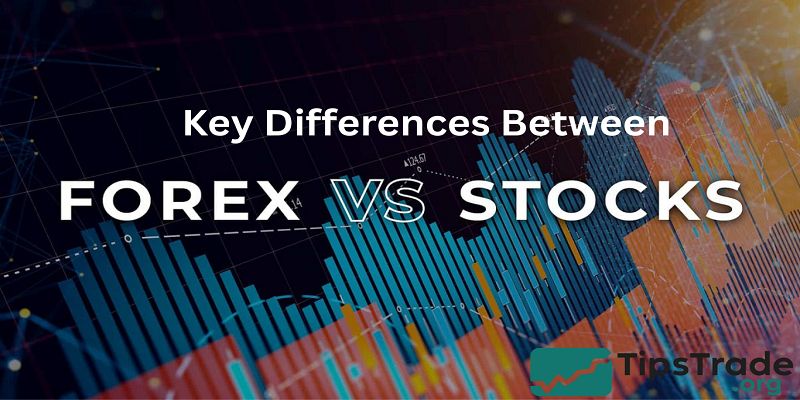Forex vs Stocks is a fundamental comparison that highlights the distinct characteristics between trading currencies and trading shares of companies. Both markets offer unique opportunities and challenges, influencing traders’ decisions based on factors such as market hours, liquidity, volatility, and risk. Understanding these differences is essential for traders and investors to choose the market that best aligns with their financial goals and trading strategies.
What Is Forex vs Stocks?

Definition of Forex Market
- The forex market is a decentralized marketplace where currencies from around the world are exchanged in pairs such as EUR/USD or GBP/JPY.
- Unlike stocks, forex does not have a central exchange; it operates over-the-counter through a network of banks, brokers, and liquidity providers.
- Forex trading appeals to day traders due to its tight spreads, leverage options up to 1:30 or higher in some regions, and 24-hour availability. It is highly accessible, allowing traders to open accounts and trade with relatively small amounts of capital, such as $100
Definition of Stock Market
- In contrast, the stock market is a centralized market where investors buy and sell shares of publicly traded companies, like Apple or Tesla.
- Purchasing stock means owning a piece of that company, and stocks are typically traded during fixed hours (for example, the NYSE operates from 9:30 a.m. to 4:00 p.m. EST).
- Stocks can provide dividends and long-term wealth accumulation, with historical average returns of about 7–10% annually on U.S. equities like the S&P 500. Stocks tend to be less volatile compared to forex and are often used for retirement planning and investment growth.
How Trading Forex Differs from Trading Stocks
- The biggest difference lies in ownership versus speculation.
- Stockholders own a piece of a company, whereas forex traders speculate on currency fluctuations.
- Forex offers high leverage and liquidity but higher short-term risks.
- Stocks, while less volatile daily, carry risks from corporate earnings and market crashes.
- Understanding these distinctions is essential before choosing a market.
>>See more:
- What is Forex? The Complete Guide for Beginners
- Learn Forex – Beginner’s Guide to Start Trading Successfully
- List of Top forex brokers in 2025 – Most Trusted and Reliable
- Forex Capital Management Tips: The Key To Success For Professional Traders
Key Differences Between Forex and Stocks

Market Hours & Accessibility
- Forex operates 24/5 across global trading sessions (Asia, Europe, U.S.), making it highly flexible for traders worldwide.
- Stock markets are limited to regional hours, though after-hours trading exists.
- This means forex suits people with irregular schedules, while stocks require alignment with exchange hours.
Liquidity & Volume
- According to BIS, forex daily turnover exceeds $7 trillion, dwarfing the $200 billion average in global stock markets.
- High liquidity ensures minimal slippage in forex, while individual stocks may face gaps and wider spreads.
- For scalpers, forex liquidity is an advantage; for long-term investors, stocks provide better stability.
Volatility & Risk
- Forex is influenced by macroeconomic events, central bank policies, and geopolitical news, often causing sharp intraday swings.
- Stocks tend to move based on company fundamentals, earnings, and industry cycles.
- While forex can change by 1–2% in hours, blue-chip stocks usually shift gradually unless major events occur.
Leverage & Margin Rules
- Most regulated forex brokers offer leverage between 1:30 (EU, UK) and 1:500 (offshore).
- Stock trading leverage is much lower—typically 1:2 for margin accounts in the U.S.
- This means forex offers higher potential profits but also amplifies losses. New traders must use leverage cautiously.
Trading Costs
- Forex traders mainly pay spreads and overnight swaps, while stock traders face brokerage commissions, exchange fees, and sometimes wider bid-ask spreads.
- For frequent trading, forex costs may be lower; for long-term holding, stocks are usually more cost-efficient.
Fundamental Drivers & News Impact
- Forex reacts strongly to central bank announcements, employment data, and inflation reports.
- Stocks depend on company earnings, dividends, and sector performance.
- However, global economic conditions can affect both, such as interest rate hikes impacting both currencies and equities simultaneously.
Similarities & Overlap Between Forex and Stocks
The use of technical analysis, market sentiment and psychology, hedging and diversification, and macroeconomic influences are all central and similarly important concepts in both forex and stock markets, though each has nuanced applications in these asset classes.
Use of Technical Analysis
- Technical analysis is heavily relied upon in both forex and stock trading. It involves using chart patterns, moving averages, momentum indicators like RSI and MACD, and candlestick formations to analyze historical price and volume data to predict future price movements.
- These tools help traders identify trends, reversals, and entry/exit points in currency pairs such as EUR/USD and stocks like Apple.
- The focus on price action and volume reduces emotional biases and enables quick, data-driven decisions that are crucial in liquid and fast-moving markets like forex and stocks.
Market Sentiment & Psychology
- Market sentiment—driven by the collective emotions of fear and greed—strongly influences trading decisions in both markets.
- Retail traders often fall prey to emotional mistakes like chasing trends or panic-selling, making psychological discipline and risk management essential across stocks and forex.
- Understanding market sentiment helps traders anticipate crowd behavior and potential price swings, which is crucial since both markets are swayed by investor mood beyond fundamental values.
Hedging & Diversification
- Both forex and stock traders use hedging and diversification to manage risk effectively. Investors often diversify across both asset types, for example by holding foreign currency positions alongside U.S. equities for geographic and currency risk hedging.
- Hedging in forex might involve taking offsetting positions in correlated currency pairs, while in stocks it could be using options or other derivatives.
- Effective hedging requires ongoing monitoring and adjustment to changing correlations and market conditions.
Influence of Macroeconomics & Monetary Policy
- Macroeconomic factors, including central bank decisions, interest rate changes, inflation, and GDP growth, significantly impact both forex and stock markets.
- For instance, a Federal Reserve rate hike typically strengthens the U.S. dollar but may depress stock market valuations due to higher borrowing costs.
- These global economic drivers create correlations and divergences that affect asset prices across markets, making fundamental analysis relevant alongside technical tools.
- In summary, despite differences in underlying assets, forex and stock markets share core analysis methods such as technical analysis and sentiment measurement, common psychological trading challenges, complementary hedging and diversification uses, and mutual sensitivity to macroeconomic developments.
- This interconnectedness offers traders the opportunity to apply integrated strategies for cross-market risk management and profit optimization
>>See more:
- What are exchange rates? How to read and analyze rates in Forex
- The Impact of Central Bank vs Forex – Understand to Invest Effectively
- Interest rate forex impact: How it affects currency value
How to Trade Forex and Stocks Together

-
Balancing a portfolio between forex and stocks depends largely on an investor’s goals and risk tolerance.
-
Risk-averse investors might allocate around 70% to equities for stable growth and dividends, with 30% in forex to diversify and hedge currency risks.
-
Contrarily, aggressive traders often favor a higher forex allocation for short-term trading gains due to its high liquidity and volatility.
-
Choosing brokers or platforms that offer both forex and stock trading, such as Interactive Brokers, IG, or Saxo Bank, simplifies portfolio management and reduces costs.
-
Beginners are encouraged to test demo accounts on these platforms before committing real funds to understand the trading environment and tools.
-
Strategy choices differ between the two markets: forex trading commonly suits short-term styles like scalping or swing trading, while stocks are generally better for long-term growth and income through dividends.
-
Combining both asset classes can provide flexibility—for example, using forex actively for income generation while holding stocks for wealth accumulation.
-
Risk management is crucial when holding positions across both markets, as it increases portfolio complexity.
-
Traders need to monitor margin requirements carefully, diversify asset classes, and avoid overexposure.
-
Implementing stop-loss orders, periodic portfolio rebalancing, and prudent position sizing are essential practices to mitigate risks effectively in a dual market portfolio.
Pros & Cons of Forex vs Stocks
| Aspect | Forex | Stocks |
| Liquidity | Very high (trillions/day) | High, but limited to exchanges |
| Hours | 24/5 trading | Limited (with after-hours) |
| Ownership | Speculative only | Ownership in companies |
| Leverage | High (1:30–1:500) | Low (1:2–1:5) |
| Costs | Spreads, swaps | Commissions, fees |
| Best For | Short-term traders | Long-term investors |
This comparison helps traders choose according to style, risk appetite, and financial goals.
Conclusion
Both forex and stocks offer unique opportunities. Forex provides liquidity, leverage, and flexibility for short-term traders, while stocks deliver ownership, dividends, and long-term stability. The choice depends on your risk tolerance and financial objectives. For many, combining both is the smartest approach—forex for active trading and stocks for wealth accumulation. The article above from Tipstrade.org has just provided you. We hope that you find it useful. Wishing you successful trading!

